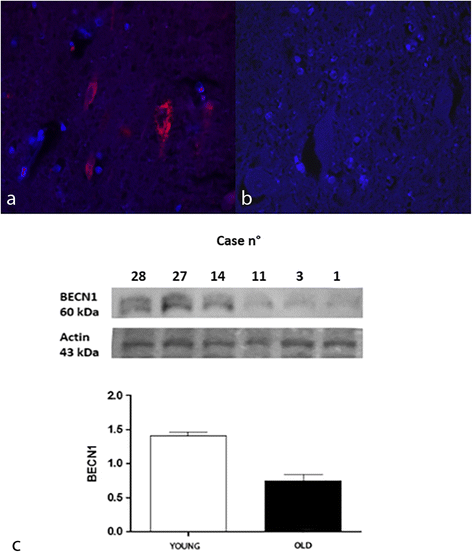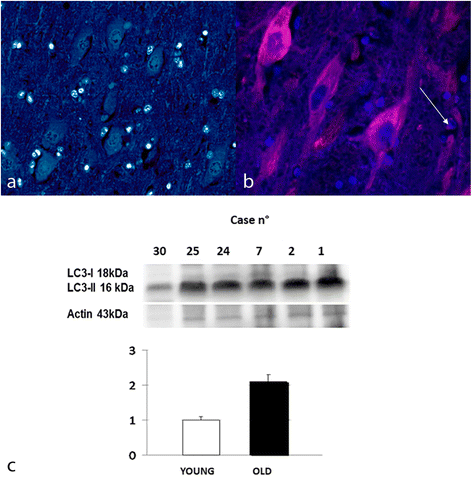Amyloid precursor protein, lipofuscin accumulation and expression of autophagy markers in aged bovine brain
- PMID: 28407771
- PMCID: PMC5390414
- DOI: 10.1186/s12917-017-1028-1
Amyloid precursor protein, lipofuscin accumulation and expression of autophagy markers in aged bovine brain
Abstract
Background: Autophagy is a highly regulated process involving the bulk degradation of cytoplasmic macromolecules and organelles in mammalian cells via the lysosomal system. Dysregulation of autophagy is implicated in the pathogenesis of many neurodegenerative diseases and integrity of the autophagosomal - lysosomal network appears to be critical in the progression of aging. Our aim was to survey the expression of autophagy markers and Amyloid precursor protein (APP) in aged bovine brains. For our study, we collected samples from the brain of old (aged 11-20 years) and young (aged 1-5 years) Podolic dairy cows. Formalin-fixed and paraffin embedded sections were stained with routine and special staining techniques. Primary antibodies for APP and autophagy markers such as Beclin-1 and LC3 were used to perform immunofluorescence and Western blot analysis.
Results: Histologically, the most consistent morphological finding was the age-related accumulation of intraneuronal lipofuscin. Furthermore, in aged bovine brains, immunofluorescence detected a strongly positive immunoreaction to APP and LC3. Beclin-1 immunoreaction was weak or absent. In young controls, the immunoreaction for Beclin-1 and LC3 was mild while the immunoreaction for APP was absent. Western blot analysis confirmed an increased APP expression and LC3-II/LC3-I ratio and a decreased expression of Beclin-1 in aged cows.
Conclusions: These data suggest that, in aged bovine, autophagy is significantly impaired if compared to young animals and they confirm that intraneuronal APP deposition increases with age.
Keywords: Ageing; Autophagy; Bovine; Brain; Neuropathology.
Figures




Similar articles
-
Impaired autophagy and APP processing in Alzheimer's disease: The potential role of Beclin 1 interactome.Prog Neurobiol. 2013 Jul-Aug;106-107:33-54. doi: 10.1016/j.pneurobio.2013.06.002. Epub 2013 Jul 1. Prog Neurobiol. 2013. PMID: 23827971 Review.
-
Regulation of amyloid precursor protein processing by the Beclin 1 complex.PLoS One. 2010 Jun 15;5(6):e11102. doi: 10.1371/journal.pone.0011102. PLoS One. 2010. PMID: 20559548 Free PMC article.
-
Beta-amyloid is a substrate of autophagy in sporadic inclusion body myositis.Ann Neurol. 2007 May;61(5):476-83. doi: 10.1002/ana.21115. Ann Neurol. 2007. PMID: 17469125
-
SGPL1 (sphingosine phosphate lyase 1) modulates neuronal autophagy via phosphatidylethanolamine production.Autophagy. 2017 May 4;13(5):885-899. doi: 10.1080/15548627.2017.1291471. Autophagy. 2017. PMID: 28521611 Free PMC article.
-
Aging: central role for autophagy and the lysosomal degradative system.Ageing Res Rev. 2009 Jul;8(3):199-213. doi: 10.1016/j.arr.2009.05.001. Epub 2009 May 7. Ageing Res Rev. 2009. PMID: 19427410 Review.
Cited by
-
Molecular and cellular pathways contributing to brain aging.Behav Brain Funct. 2021 Jun 12;17(1):6. doi: 10.1186/s12993-021-00179-9. Behav Brain Funct. 2021. PMID: 34118939 Free PMC article. Review.
-
Mini-Review on Lipofuscin and Aging: Focusing on The Molecular Interface, The Biological Recycling Mechanism, Oxidative Stress, and The Gut-Brain Axis Functionality.Medicina (Kaunas). 2020 Nov 19;56(11):626. doi: 10.3390/medicina56110626. Medicina (Kaunas). 2020. PMID: 33228124 Free PMC article. Review.
-
Age-related changes in tau and autophagy in human brain in the absence of neurodegeneration.PLoS One. 2023 Jan 26;18(1):e0262792. doi: 10.1371/journal.pone.0262792. eCollection 2023. PLoS One. 2023. PMID: 36701399 Free PMC article.
-
Current understanding of metal ions in the pathogenesis of Alzheimer's disease.Transl Neurodegener. 2020 Apr 3;9:10. doi: 10.1186/s40035-020-00189-z. eCollection 2020. Transl Neurodegener. 2020. PMID: 32266063 Free PMC article. Review.
-
Post-Slaughter Age Classification and Sex Determination in Deboned Beef Using Lipofuscin Autofluorescence and Amelogenin Gene Analysis.Vet Sci. 2025 Jun 17;12(6):593. doi: 10.3390/vetsci12060593. Vet Sci. 2025. PMID: 40559830 Free PMC article.
References
-
- Selkoe DJ, Podlisny MB, Joachim CL, Vickers EA, Lee G, Fritz LC, Oltersdorf T. Beta-amyloid precursor protein of Alzheimer disease occurs as 110- to 135-kilodalton membrane-associated proteins in neural and non neural tissues. Proc Nat Acad Sci U S A. 1988;85(19):7341–7345. doi: 10.1073/pnas.85.19.7341. - DOI - PMC - PubMed
MeSH terms
Substances
LinkOut - more resources
Full Text Sources
Other Literature Sources

